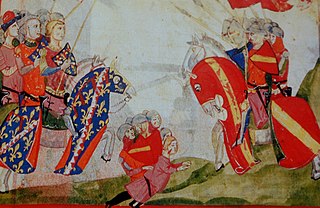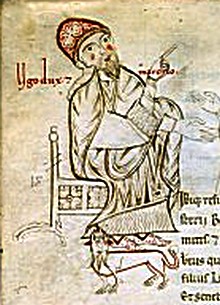

The Cambridge Medieval History is a history of medieval Europe in eight volumes published by Cambridge University Press and Macmillan between 1911 and 1936. Publication was delayed by the First World War and changes in the editorial team.


The Cambridge Medieval History is a history of medieval Europe in eight volumes published by Cambridge University Press and Macmillan between 1911 and 1936. Publication was delayed by the First World War and changes in the editorial team.
The work was planned by John Bagnell Bury, Regius Professor of Modern History at Cambridge University, along lines developed by his predecessor, Lord Acton, for The Cambridge Modern History . The first editors appointed were Henry Melvill Gwatkin, Mary Bateson, and G.T. Lapsley. James Pounder Whitney replaced Mary Bateson following her death in 1906. When G.T. Lapsley retired due to ill health, his place was not filled so that the editors of the first two volumes were Gwatkin and Whitney. [1]
In the preface to the first volume, the editors expressed the wish that the work would be an interesting read for the general user as well as "a summary of ascertained facts, with indications (not discussions) of disputed points". They claimed, "there is nothing in the English language resembling the present work" and wrote, optimistically, that they "hoped to publish two volumes yearly in regular succession". [1] In fact, the final volume was not published until 1936.
The history aimed to encompass the whole of European medieval history so that the editors were obliged to use a wide range of contributors in order to adequately treat the subject. In particular in relation to volume 2 (The Rise of the Saracens and the Foundation of the Western Empire) the editors complained that "students of history in this country [England] seldom turn their attention to any part of it" and thus "very little has ever been written in English, [on subjects] such as the Visigoths in Spain, the organisation of Imperial Italy and Africa, the Saracen invasions of Sicily and Italy, and the early history and expansion of the Slavs". [2]
Volumes one and two were published in 1911 and 1913, keeping to the expectation of the editors that the work would move through its volumes at a fast pace.
Volume three, however, was delayed until 1922 by the First World War, which made international collaboration more difficult, and after German scholars had been replaced by British ones due to worries about how the volume would be received in Britain. Some went unpaid as they had signed no contract. A collection was organised for the great German Latinist Max Manitius which raised £10 after he wrote that the war had left him in poverty. Contributors to volumes four and six were similarly affected. [3] Writing in the preface to volume II of The New Cambridge Medieval History in 1995, Rosamond McKitterick commented on the "unhappy legacy of the old volume III when the principles of scholarship were sullied with political enmities and many scholars excluded as authors because of their nationality", a fault that she felt was expunged in the new history. [4]
The editors of volume three were Gwatkin, Whitney, Joseph Robson Tanner, and Charles William Previté-Orton. The volume was criticised in review for duplication in its coverage of events and definitions, and a failure to cross-reference material, [5] but later commentators saw this as the inevitable consequence of the structure of the work as a collection of scholarly essays drawn from a range of international contributors over 25 years, disrupted by war and changes of editor, rather than an organic synthesis prepared by a small group over a short time-frame. [6]
Volumes four to seven (1923–32) were edited by Tanner, Previté-Orton and Zachary Nugent Brooke (1883-1946) after Brooke replaced Whitney on his retirement. After Tanner died in 1931, volume eight (1936) was completed by Previté-Orton and Brooke.
In 1966 and 1967, a new edition of volume four was published in two parts edited by Joan Hussey that incorporated developments in the field of Byzantine studies in the forty years since the original was published. [7]

Louis the Blind was the king of Provence from 11 January 887, King of Italy from 12 October 900, and briefly Holy Roman Emperor, as Louis III, between 901 and 905. He was the son of Boso, the usurper king of Provence, and Ermengard, a daughter of Emperor Louis II. Through his father, he was a Bosonid, but through his mother, a Carolingian. He was blinded after a failed invasion of Italy in 905.

Philip I of Taranto, of the Angevin house, was titular Latin Emperor of Constantinople by right of his wife Catherine of Valois–Courtenay, Despot of Romania, King of Albania, Prince of Achaea and Taranto.
Uguccione della Faggiuola was an Italian condottiero, and Ghibelline magistrate of Pisa, Lucca and Forlì.

Frederick II, son of Thierry I of the House of Ardennes and Richilde von Blieskastel, daughter of Folmar III, Count in Bliesgau, was the count of Bar and duke of Lorraine, co-reigning with his father from 1019.
Conrad I, called the Peaceful, a member of the Elder House of Welf, was King of Burgundy from 937 until his death.

The Battle of Montecatini was fought in the Val di Nievole on 29 August 1315 between the Republic of Pisa, and the forces of both the Kingdom of Naples and the Republic of Florence. The army of Pisa, commanded by Uguccione della Faggiuola, won a victory. The Neapolitan forces, made up of 3200 cavalry and 30,000-60,000 infantry, were commanded by Philip I of Taranto, while the Pisan forces consisted of 3000 cavalry and 20,000 infantry.
Henry Melvill Gwatkin was an English theologian and church historian.
Herman IV was the Duke of Swabia (1030–1038). He was the second son of Ernest I and Gisela of Swabia. He was one of the Babenberg dukes of Swabia.

Otto I, called Otto of Worms, a member of the Salian dynasty, was Duke of Carinthia from 978 to 985 and again from 1002 until his death.
James Pounder Whitney was a British ecclesiastical historian.
The Treaty of Benevento or Concordat of Benevento was an important treaty between the papacy of Adrian IV and the Norman Kingdom of Sicily. After years of turbulent relations, the popes finally settled down to a peace with the Hauteville kings.
Hubert was the illegitimate son of King Hugh of Italy and his concubine Wandelmoda. He became Margrave of Tuscany in 936 and Duke of Spoleto and Margrave of Camerino in 943.

Hugh, called the Great, was the Margrave of Tuscany from 969 until his death, and the Duke of Spoleto and Margrave of Camerino from 989 to 996. He restored the state apparatus in Tuscany after decades of neglect by margraves whose main interests lay elsewhere. Hugh supported the new Ottonian dynasty, and was praised for his justice by the contemporary theologian Peter Damian in his De principis officio.
Conrad II the Younger was the Count of Auxerre from 864 until his death in 876. He was a son of Conrad I of Auxerre, and Adelaide of Tours; an older brother of Hugh the Abbot; and a member of the Bavarian branch of the Welfs.
Eustathius was Ecumenical Patriarch of Constantinople from July 1019 to December 1025.
Sarlio was the Duke of Spoleto from 940 until 943. He was originally from Provence and served as a count of the palace under King Hugh.

Charles William Previté-Orton was a British medieval historian and the first Professor of Medieval History at the University of Cambridge on the establishment of the position in 1937.
The Battle of Toulouse in 844 was part of the campaign by Charles the Bald in Aquitaine to force the submission of Pepin II of Aquitaine, the rebellious son of Pepin, the half-brother of Charles. The historical context of this battle is the three-year Carolingian civil war, culminating in the Battle of Fontenay-en-Puisaye in 841. Here Charles and Louis the German defeated their brother Lothair I, who retreated to the south with his army.
The Siege of Eltville in May 1349 was the military engagement by which Charles IV secured the throne of the Holy Roman Empire against his rival, Günther of Schwarzburg. It was the third time a disputed succession in the Empire had been decided by battle.

The Shorter Cambridge Medieval History is a two-volume history of medieval Europe by Charles Previté-Orton (1877–1947), prepared for publication by Philip Grierson, and published by Cambridge University Press in 1952. It is a condensed and revised version of The Cambridge Medieval History which was published in eight volumes between the World Wars and, unlike that work, was intended for a general audience.